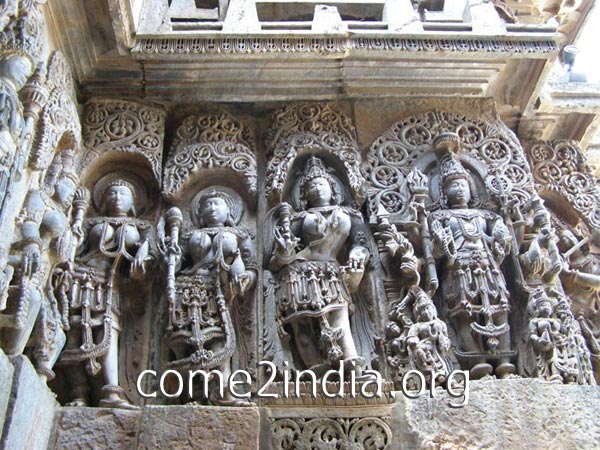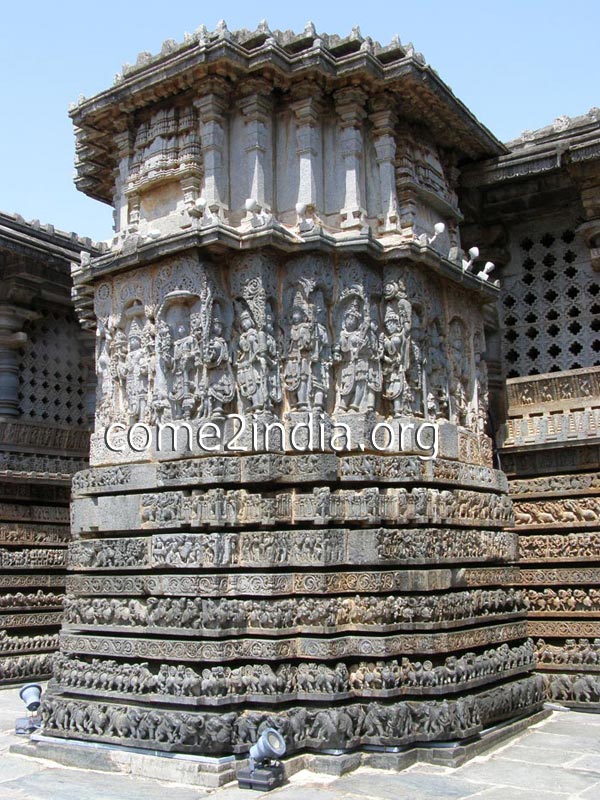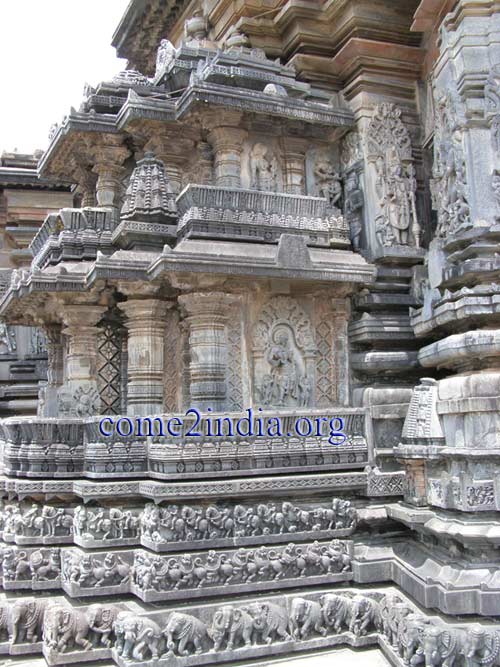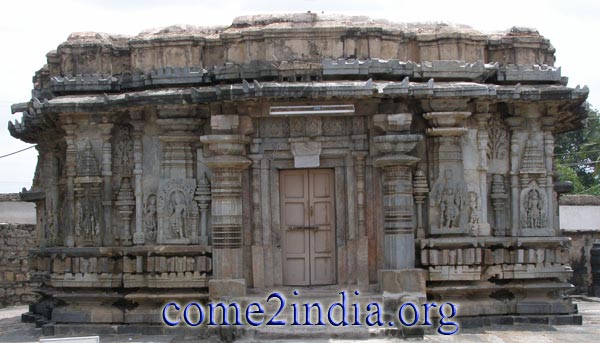|
|

Belur was the capital of Hoysala Empire who were great patrons of Art. The Chennakeshva temple is an eternal Beauty - a masterpiece built during the reign of King Vishnuvardhana in 1117 AD. The inscriptions speak of its master builders (Sthapathi)as Dasoja and his son Chavana. But legends ascribe this feat to Jakanachari. Standing on a wide elevated platform, the temple looks like a casket and is 178 feet long (east to west) and 156 feet wide. The Shikara - the superstructure is now gone.
Belur known as Velapuri going by the inscriptions, was the first capital of Hoyasalas. Hoysala King Vishnuvardhana (A.D. 1108-1152) built Chennakeshava temple after he adopted Vaishnavism as advised by his Guru Sri Ramanujacharya. His Queen Shantala Devi, a serious patron of arts and dance (herself a consummate dancer) was instrumental in giving shape to many of the Sculptures. An inscription on the pedestal of Vijayanarayana image states that the image was caused to be made by king Vishnu (Vishnuvardhana). It is actually Keshava one of the 24 forms of Vishnu.

The Chennakeshava temple in Belur, located about 38 km from Hassan - a small town about 170 km from Bangalore (now Bangalooru) Karnataka was built to commemorate the victory over the Tamil Chola Viceroy at Talakkad. The temple style has shades of the traditional southern Hindu temples built by Cholas in Tanjore and Pallavas in Kanchipuram - both in Tamilnadu. Yet the Hoysala temples differ by the intricate and detailed stone sculptures which are unique. They also bear the influence of the Western Chalukya Kingdom.
The builders of the temple had thought of minute details before executing their work in the soft soapstone. For example, their massive stone edifice had to rest on ornate pillars and the nature of the soft soapstones of which the pillars were hewn out precluded the use of cold chisels to carve out the intricate shapes they wanted. They had used lathe to shape the uniformly circular pillars.
Chennakeshva temple The temple was built using the soft soapstones with very intricate carvings, life size sculptures of Gods and Goddesses, circular lathe turned pillars and rows upon rows of exceptionally beautiful friezes on the outer walls. Consists of a Garbhagriha (sanctum) a Sukhanasa (vestibule) and a Navaranga. It is particularly noteworthy that the ground plan of the Garbhagriha is star-shaped. The Navaranga pavilion is a large hall with beautifully designed lathe turned and polished pillars and ceiling and has entrances on the east south and north.
The rows of friezes may depict a row of Elephants, a series of Lion faces above that, while the third row may consist of artistic foliage with another row full of bead garlands. Another row depicts a small army of men and women engaged in dancing and playing musical instruments. The sixth row has nubile damsels in various poses in between small niches created by miniature ornate pillars. Above this on the Garbhagriha walls, there are taler figures of 24 manifestations of Vishnu. All the outer walls contain series of Puranic episodes engraved in relief. The exquisite beautiful bracket figures of incredibly detailed Dancing Girls are cast in stone on the outer walls of the 40 pillars - preserved for hundreds of years.
The tall monolithic pillars in the Navaranga - the inner pavilion are stellar in shape or circular in outline with motifs like flower vase, water vase, Kumbha etc. The Mohini pillar in the Navaranga is one of the finest specimens. The pillar is cut vertically on sixteen pointed star plan. It is decorated with a narrow band of filigree work.
The four bracket figures of damsels on the four pillars in the Navaranga are remarkable creations and one of them is identified as of Queen Shantala - a noted accomplished dancer. They are popularly called as "Madanika" images. They are finely proportioned and exceptionally adorned with ornaments. Of the bracket figures mention may be made of Darpanasundari, Sukhabhashini, Modesty and the monkey, Huntress and Natya Mohini. Most of these images have inscriptions on the pedestal mentioning the names of the sculptors who carved them.
The eastern face of the pillar has a large beautifully carved image of Vishnu as Mohini exceedingly graceful with a Chauri bearer and Garuda on the other. The central square of the Navaranga has four pillars decorated with bracket figures atop. These bracket figures are of remarkably superior workmanship in conception and execution. The central Vimana is elegantly carved with friezes of varied sculptures most of them being mythological in nature. The side walls have sculptures of scenes from Puranas and durbar scenes of King Vishnuvardhana, King Narasimha I (A.D. 1152-1173) and Ballala II (A.D. 1173-1220).

The outer face of the walls of the Garbhagriha and the Antarala are adorned with beautiful images of deities 80 in number, of which about 19 are of Goddesses. The sculptural depictions of Vishnu as Lakshminarayana, Vamana, Narasimha, Varaha and Balarama with that of Shiva and Parvati along with Andhakasura, Gajasura, Harihara, Surya, Durga, Mahishasuramardini, Bhairava,Brahma, Rati and Manmata could be considered as the best representations of the Hoysala sculptural art. Essentially Chennakesava temple of the Hoysala style occupies a distinct place amongst the architectural wonders of India. The poetry in stone - sculptural poetry immortalizes the achievements of Vishnuvardhana and the sculptors like Dasoja, Chavana his son, Chikkahampa, Malliyana, Padari malloja, Masada and Nagoja who bestowed their best in creating this masterpiece.
Kappe Chennigaraya Temple: Kappe Chennigaraya Temple is located in the south side of ChennaKeshava temple. It has two parts. The main part has a beautiful sculpture of ChennaKeshava - about 6.5 feet over the pedestal. The Prabhavali ( the ornate arch made of stone in this case) has Dasavatara (the ten incarnations of Vishnu) sculptures. The Pitha (pedestal) has an inscription of Queen Shantala of Hoysala King Vishnuvardana stating that it was consecrated by her in the year 1117 AD. The temple rises over an elevated platform. The perforated Jalandras (side walls) were done at the time of Ballala II in 1206. The Sukhanasi doorway is beautifully executed with a figure of Lakshminarayana flanked by makaras on the lintel. The doorway of the Venugopal Shrine has the figure of Narasimha killing Hiranyakashipu. The niches on the outer walls of the Sukhanasi has exquisite sculptures of Lakshminarayana, Ganesha, Saraswati and Mahishamardini. The 4 pillars of the Navaranga are, as is common in Hoysala architecture, lathe turned and have bracket figures on them.

Veera Narayana Temple: Located to the west of Keshava temple is a small and compact structure with the outer walls containing beautiful sculptures of Vaishnava and Shaiva faith. It consists of a Garbagriha (sanctum sanctorum), a Sukhanasi and a Navaranga. The 59 large images on the outer wall surfaces depict Vishnu, Shiva, Brahma, Parvati, Saraswati, Bhairava, Ganesha and Mahishamardini amongst others.
|














































